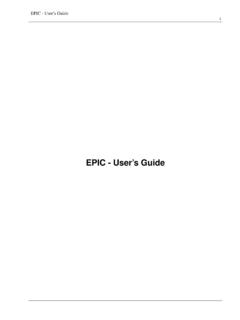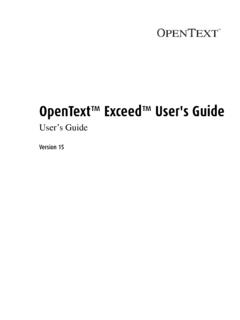Transcription of GTKWave 3.3 Wave Analyzer User's Guide
1 GTKWave Wave Analyzer User's Guide GTKWave Wave Analyzer User's Guide 1 GTKWave Wave Analyzer User's Guide 2 User's GuideGTKWave GTKWave Wave Analyzer User's Guide 3 Updated Nov 14, manual supports GTKWave and higher (c) 1998-2020 BSIP ortions of GTKWave are Copyright (c) 1999-2020 Udi Finkelstein. Context support is Copyright (c) 2007-2020 Kermin Elliott group support is Copyright (c) 2009-2020 Donald and additional GUI support is Copyright (c) 2005-2020 Tristan support is Copyright (c) 2005-2020 Thomas DnD support is Copyright (c) 2008-2020 Concept Engineering is Copyright (c) 2005-2020 Ariya is Copyright (c) 2011-2020 Yann is free software. See for more information on the GNU GPL General Public License version 2. There is NO warranty; not even for MERCHANTABILITY or FITNESS FOR A PARTICULAR information in this document is subject to change without notice.
2 GTKWave Wave Analyzer User's Guide 4 ContentsUsing This Printing and Installing Unix and Linux Operating Microsoft Windows Operating Apple Macintosh Operating GTKWave Why Use GTKWave ?..16 What Is GTKWave ?..18 GTKWave user Main Window ..19 Toolbutton Signal Wave Navigation and Status Menu Ergonomic Scroll The Primary Interactive Menu GTKWave Wave Analyzer User's Guide 5 Sample Launching Displaying Signal Hierarchy Tree Signal Save Pattern Alias Files and Attaching External Debugging the Source A: Command Line Options B.
3 Gtkwaverc Variable C: VCD VList Recoding Time Single-bit Multi-bit Reals and String Final Notes on VCD GTKWave Wave Analyzer User's Guide 6 Appendix D: LXT File LXT LXT Section LXT Section The lxt_write E: Tcl F: Implementation of Illustration Alphabetical GTKWave Wave Analyzer User's Guide 7 GTKWave Wave Analyzer User's Guide 8 Using This ManualPrinting ConventionsText printed in the font courier reflects messages that will be seen on screen at a command prompt or as program printed in courier bold is to be entered by the printed in smaller monospace is help available either as a manual page or as a program help printed in italics is a pathname in the file system or is the name of an application program.
4 GTKWave Wave Analyzer User's Guide 9 GTKWave Wave Analyzer User's Guide 10 Compiling and Installing GTKWaveUnix and Linux Operating SystemsCompiling GTKWave on Unix or Linux operating systems should be a relatively straightforward process as GTKWave was developed under both Linux and AIX. External software packages required are GTK ( ) with versions or ( not yet supported), and gperf (for RTLB rowse) which can be downloaded from the GNU website ( ). The compression libraries libz (zlib) and libbz2 (bzip2) are not required to be installed on a target system as their source code is already included in the GTKWave tarball, however the system ones will be used if and InstallingUn-tar the source code into any temporary directory then change directory into it. After doing this, invoke the configure script.
5 Note that if you wish to change the install point, use the double dash --prefix option to point to the absolute pathname. For example, to install in /usr, type ./configure --prefix= :/ > ./configureUse the --help flag to see which options are available. Typically, outside of --prefix, no flags are :/ > makeWait for the compile to finish. This will take some amount of time. Then log on as the :/ > suPassword: [root@localhost ]# make install GTKWave Wave Analyzer User's Guide 11 Wait for the install to finish. It should proceed relatively quickly. When finished, exit as superuser.[root@localhost ]# exitexitGTKWave is now installed on your Unix or Linux system. To use it, make sure that the bin/ directory off the install point is in your path. For example, if the install point is /usr/local, ensure that /usr/local/bin is in your path.
6 How to do this will vary from shell to shell. GTKWave Wave Analyzer User's Guide 12 Figure 1: GTKWave running under Windows Operating SystemsCygwinThe best way to run GTKWave under Windows is to compile it to run under Cygwin. This will provide the same functionality as compared to the Unix/Linux version and better graphical performance than the native binary version. Follow the directions for Unix compiles in the preceding section. Note that launching RTLB rowse requires Cygserver to be enabled. Please see the Cygwin documentation for information on how to enable Cygserver for your version of Cygwin. ( )MinGW versus VC++ for Native BinariesIt is recommended that Windows compiles and installs are done in the MinGW environment in order to mimic the Unix shell environment as well as produce binaries that are natively usable on Windows.
7 Producing native binaries with VisualC++ has not been attempted for some time so it is currently with you are missing a working version of gtk-config, you will need a fake gtk-configfile in order to compile under It will look like this with the include and linker search directories modified accordingly:#!/bin/shif [ "$1" == "--libs" ] then echo -L/home/bybell/libs -lgck -lgimpi -lgnu-intl -ljpeg -llibgplugin_a -llibgplugin_b -lpng -lpthread32 -ltiff-lzw -ltiff-nolzw -ltiff fiif [ "$1" == "--cflags" ] then echo " -mms-bitfields -I/home/bybell/src/glib -I/home/bybell/src/gtk+/gtk -I/home/bybell/src/gtk+/gdk -I/home/bybell/src/gtk+ " fiCompiling as under Unix/Linux is the with do not need to do anything special except ensure that pkg-config is pointed to by your PATH environment variable.
8 Proceed as with Pre-made binaries can be found at the website. GTKWave Wave Analyzer User's Guide 13 Apple Macintosh Operating SystemsOSX / MacportsAll functionality of the Linux/UNIX version is present in the OSX version when GDK/GTK is compiled for X11. If GDK/GTK is compiled for Quartz ( , /opt/local/etc/ has a line of the form +no_x11 +quartz) and the package gtk-osx-application is also installed, GTKWave will behave more like a Mac application with native menus, an icon on the dock, etc. as shown that if running GTKWave on the command line out of a precompiled bundle , it is required that the Perl script is invoked to start the program. Please see the GTKWave (1) man page for more information. GTKWave Wave Analyzer User's Guide 14 Figure 2: Demonstrating application integration with Mac OSX / QuartzIntroductionGTKWave OverviewGTKWave is an analysis tool used to perform debugging on Verilog or VHDL simulation models.
9 With the exception of interactive VCD viewing, it is not intended to be run interactively with simulation, but instead relies on a post-mortem approach through the use of dumpfiles. Various dumpfile formats are supported: VCD: Value Change Dump. This is an industry standard file format generated by most Verilog simulators and is specified in IEEE-1364. This is the slowest of the formats for the viewer to process and requires the most memory, however the format is ubiquitous and almost all tools support it, which is why native support remains. Note that recent versions of the viewer default to dynamic VCD recoding in memory through some interesting tricks with zlib compressed VLists. (See Appendix C: VCD Recoding on page 97.) This greatly reduces the amount of memory required to store a large, full (non-interactive) VCD trace in memory such that in many cases, less memory is required than the actual size of the trace itself.
10 Nevertheless, using one of the database formats will almost always be more efficient for larger traces, especially if they are to be viewed repeatedly. ( , the speed hit for converting a trace to a database format is offset by the repeated cost of recoding VCD every time the trace is viewed.) The more physical memory that is available on a machine beingused to view VCD, the better. LXT: InterLaced eXtensible Trace. This is an optimized format utilizing interleaved back pointers and value changes. Processing LXT files is fasterthan VCD. It was created specifically for use with GTKWave , however someother simulators (notably, Icarus Verilog) support it natively. LXT2: InterLaced eXtensible Trace Version 2. This is a block-based variantof LXT that allows for greater compression and access speeds than can be achieved with LXT.






